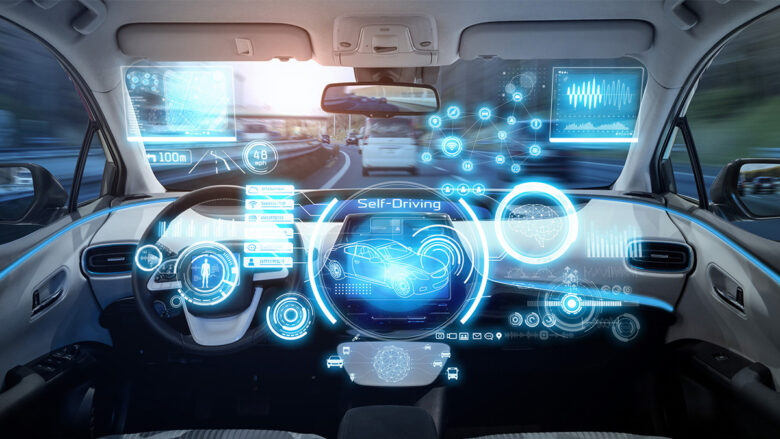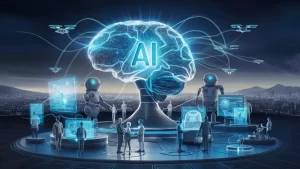Self-driving cars require extensive and sophisticated hardware capable of integrating, processing, and interpreting data in real time. Such systems must be highly reliable to gain public trust and avoid safety concerns. Artificial intelligence algorithms enable autonomous vehicles to interpret their environments and make real-time decisions based on sensor data in real time. These AI features play an essential part in their transformative impact on transportation industries:
1. Safety
AI-enabled cars utilize sensors and cameras to “see” their surroundings, including pedestrians, other vehicles, lane markings, and traffic lights, to navigate and adhere to road rules.
Some vehicles even include computer vision systems to understand what they see so they can predict future movements of pedestrians and objects to avoid collisions and make safer driving decisions. This system helps them prevent collisions by offering accurate predictions. But to ensure their safety in dynamic conditions and unpredictable human behaviors and build public trust. Auto manufacturers need to focus on transparency and education to address these challenges effectively.
2. Energy Efficiency
AI technology can make vehicles more fuel-efficient, helping reduce emissions and meet sustainability goals. Furthermore, vehicle-to-everything (V2X) communication and AI chips enable drivers to optimize performance more efficiently while decreasing energy usage costs and fleet management expenses.
Behavior Prediction: Self-driving cars trained on vast amounts of naturalistic driving data use neural networks trained on naturalistic data to accurately forecast potential behaviors from other road users, such as pedestrians or vehicles, to prevent collisions proactively and plan optimized routes so as to reach their destinations smoothly without close calls or close encounters.
Consumers may initially be skeptical about AI in cars, but companies that prioritize transparency and safety, including extensive testing, can build trust among consumers that opens the way for innovative services like hyper-personalized on-demand transportation services.
3. Accessibility
Accessibility refers to the degree to which products, services, and environments can be utilized by people with disabilities. This can include features like audio descriptions in videos, large font sizes, and high contrast between background colors and font colors.
AI can aid accessibility in multiple ways, from improving voice recognition to improving navigation and information systems. AI can also be used to customize entertainment and safety systems specifically tailored for individual drivers as well as provide support for those with cognitive impairments and even identify drivers exhibiting signs of distracted driving. For more on this topic, check out our blog post here.
4. Eco-friendliness
Going green refers to practices designed to mitigate environmental damage. AI technology is helping in this effort by making transportation more eco-friendly.
Object detection, behavior prediction, and route optimization all play an integral role in optimizing energy consumption and emissions reduction – essential capabilities for developing self-driving cars to address climate change and pollution concerns. Generative models can enhance image resolution and fill gaps in sensor data to provide a more complete picture of an autonomous vehicle’s surroundings, which improves their environment perception and decision-making ability.
5. Convenience
AI algorithms use sensor data to process and predict, allowing autonomous vehicles (AVs) to plan routes efficiently while avoiding collisions and reaching their destinations efficiently.
Perception & Sensor Fusion
AI models trained on vast amounts of naturalistic driving data enable autonomous vehicles to sense their environment, detect obstacles, and predict behaviors of surrounding road users, making for safer navigation. Furthermore, advanced models identify anomalies to help avoid potential collisions.
AI-enhanced platooning and routing capabilities at a traffic network level have proven their worth in significantly reducing congestion, emissions, and accessibility for people with disabilities and elderly individuals, as well as helping passengers use travel time more productively for work/leisure activities.
6. Autonomy
AI plays an essential part in providing self-driving cars with an intelligent system capable of perceiving environments and maneuvering roads independently. Predictive Behavior Analysis By analyzing patterns in driving data, AI allows vehicles to anticipate the behaviors of nearby road users – such as whether pedestrians will cross the street – enabling cars to avoid collisions proactively – something essential for safe autonomous operation.
Sensor Fusion AI algorithms help autonomous vehicles (AVs) combine information from multiple sensors such as cameras, radars, and LiDARs in order to understand road conditions in three dimensions more quickly and improve navigation accuracy. Edge AI processes data locally on vehicle hardware, eliminating cloud computing’s latency and providing instantaneous response times and adaptability in adapting to unexpected road hazards.
7. Real-time Decision-Making
Real-time decision-making enables businesses to react immediately to changes in their environment. This capability is especially critical in high-stakes situations where lives may be at stake, such as military operations, event security teams, first responders, and ski resort operators who rely heavily on real-time decision-making capabilities for making important decisions quickly and without delay.
Autonomous driving cars utilize AI to process data and perceive their environments and make decisions autonomously, sensing obstacles and road conditions while algorithmically assessing driver fatigue and environmental risks. Lane-keeping assists ensure stable lane adherence, while self-correcting systems quickly react to unavoidable accidents. Autonomous vehicles also help increase efficiency and traffic flow with AI capabilities like platooning, route/energy optimization at network levels, and self-correction abilities.
8. Communication
Artificial intelligence can be utilized to improve different aspects of autonomous vehicles. This includes object detection, path planning, and behavior prediction. AI also can aid with redundancies and failsafe mechanisms to make self-driving cars safer.
Autonomous vehicles use various sensors to accurately perceive their environments, such as LiDAR, radar, and cameras. These sensors create a 3D map of their surrounding environment with unsupervised learning algorithms used to extract important data points for better perception and interpretation – including MODEST (Mobile Object Detection with Ephemerality and Self-Training), which also creates memories of past traversals for further use by HINDSIGHT (Human Induced Dynamic Neural Simulation Technology).




